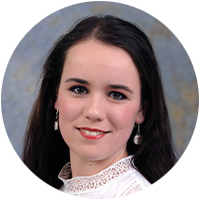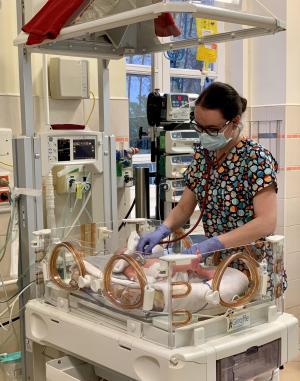Kata Kovács, MD, PhD | Foundations of Clinical Research

Kata Kovács, MD, PhD, is a clinician completing her residency at the Semmelweis University 1st Department of Pediatrics in Budapest, Hungary. But she has a second love, one that she started in medical school—pediatric research. She began the focus in medical school, and even though the experience taught her that she doesn't want to work in a lab, she wants to combine her clinical and research work into a single career.
Within her Semmelweis PhD program she had another opportunity to hone her work, "We did a randomized clinical trial in the neonatal intensive care unit, which doesn't often happen in a clinical environment in Hungary," she says. "That made me feel sure that I'd like to continue with research."
Currently, Kovács is planning to work primarily in neonatology and hemodynamics. She'll finish her residency in April and, before she moves on to a neonatal fellowship, wants to do more research. To become a clinician and a researcher, she's looked to her clinical supervisor as a role model, but she also decided to apply to the Harvard Medical School Foundations of Clinical Research (FCR) program with a fellow colleague in her department.
FCR helps with foundational knowledge to help health care professionals learn how to produce clinical research with a particular focus on epidemiology and biostatistics. Kovács is planning on graduating in January 2022, but already it's helped push her forward both in knowledge base and career.
An International, Group-Focused Program
Kovács is grateful that her fellow Semmelweis colleague is attending the program with her, since she's never done an all-remote program before. She explains, if the program hadn't been fully remote, "I might not have the opportunity in the first place. This way it feels like more of an international program."
Thus, the small group programs, breakout sessions, and social elements of the program were particularly effective for her—both from a clinical perspective and improving her English language skills, she says. She's neither an expert nor a novice in either biostatistics or epidemiology; the program is perfect for her to both learn more while drawing from her experience base and working with classmates of various skill levels. The fact that everyone in the program has different backgrounds and clinical challenges was similarly helpful to her.
"I don't know if I'll be able to work with classmates in the future, but that would be such an incredible opportunity. We're close to each other in terms of progression in our career, and there's such a possibility for collaboration," she says. She and other classmates already have ideas for future projects.
All the faculty have been helpful, but she says she draws particular inspiration from Kenneth Christopher, MD, SM, faculty director of the program. Looking to the future, she says she'd like to be a supervisor to her own PhD students and design her own research studies, and looking to Christopher and the other faculty is providing her a blueprint for how she'd like to teach and lead.
Projects Based on Impact
The two FCR projects require that students develop a unique research question and then develop it with statistical analysis, an abstract, and finally an e-poster presentation. In Kovacs' case, she chose from a database that covered a neonatal cohort from India and developed a design study that focused on a basic, but essential research question—is there an association between maternal social status and preterm birth within that cohort?
She's still working on the statistical analysis to determine the exact statistical relevance, but the issue has already proven to be relevant. "In FCR, we learn that we shouldn't think about just one relevant question but what can be answered in the database. I have many questions I'd like to answer from my own clinical experience, but I need the data," she says. So she's particularly excited to get faculty feedback on her presentation in order to develop more questions in the same topic area in the future.
The practice of developing research is also helpful for future work. She says, "I feel that I don't have to automatically ask a biostatistician my basic questions—I can do it myself. I can hone the research question, write the abstract, do the basic analysis, and hopefully write a publication alone." Since neonatology and hemodynamics are both emerging fields, she has a wealth of ideas to explore, and she'd like to bring more research opportunities to institutions in Budapest and Hungary.
Looking Ahead to Opportunities
After she graduates, Kovacs aims to dedicate time to research and applying for research scholarships—carving her own unique path forward. In fact, she's already received funding from the European Society for Pediatric Research and will start a new project soon that combines both of her concentrations—a new pharmacological drug that pairs with hypothermia treatment for babies with hypoxic-ischemic encephalopathy. She's excited to begin work on it and push forward her knowledge base and expertise.
So FCR has done exactly what she'd hoped in galvanizing her career and making her feel proficient in her research abilities. "It's like one of my dreams came true—growing up and in my schoolwork, it felt like nobody gets to go to Harvard, but now I'm there, and I'm very lucky," she says. "It's a great honor."
Learn more aboutFoundations of Clinical Research.
Written by Katherine J. Igoe